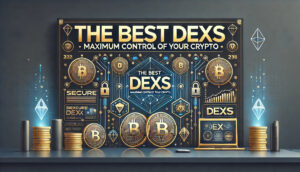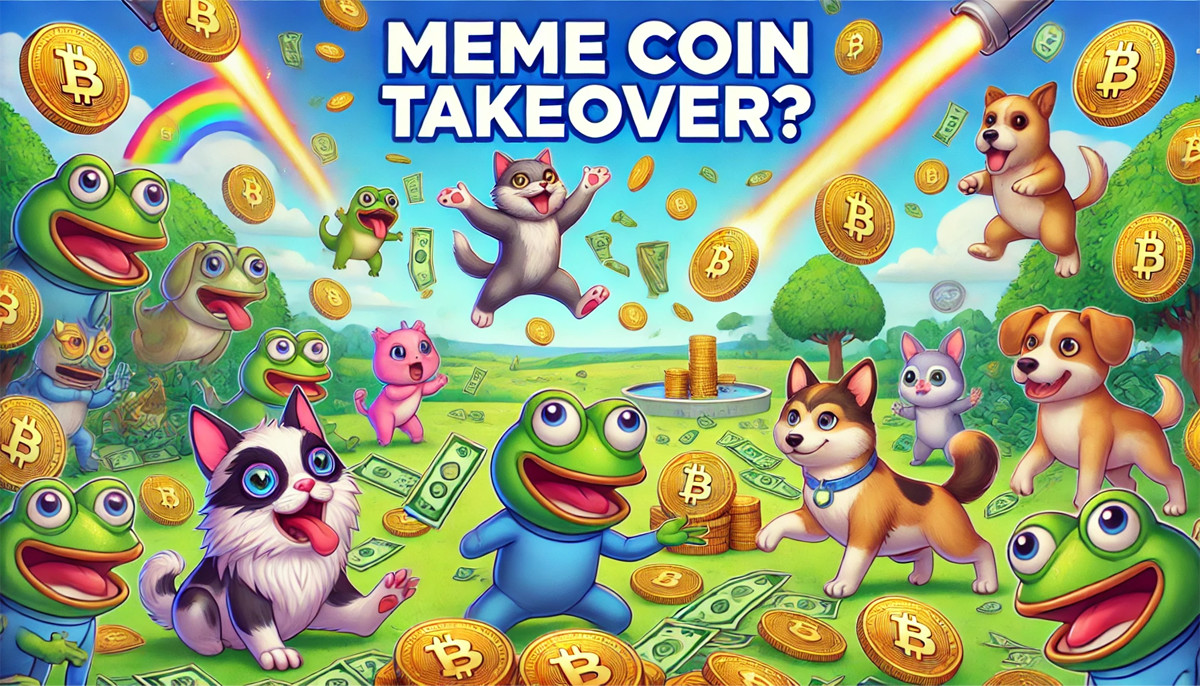The world of cryptocurrency is constantly evolving, and one of the most notable trends in recent years has been the rise of meme coins. These playful, community-centric digital assets have sparked a mix of enthusiasm and doubt among crypto enthusiasts. From the viral success of Dogecoin to the growing fame of Shiba Inu and newer coins like Pepe and Floki Inu, meme coins are gaining attention and carving out a unique space within the market.
But their rise prompts an important question: are meme coins truly taking over the crypto market, or is their popularity just another fleeting trend? With a strong blend of online hype, social media influence, and community-driven value, meme coins are undoubtedly shaking things up. However, understanding their impact and whether they’ll have lasting power requires a closer look at what’s fueling this phenomenon and how it could shape the future of cryptocurrency.

What Are Meme Coins?
Meme coins are cryptocurrencies that are often inspired by internet memes, jokes, or viral content. Unlike Bitcoin or Ethereum, which were created with specific technological advancements or decentralized finance (DeFi) applications in mind, meme coins are generally more about community and hype.
Dogecoin, the most famous example, was created in 2013 as a joke based on the popular Doge meme, featuring the Shiba Inu dog. Despite its origins, Dogecoin became a cultural phenomenon and gained the backing of high-profile figures like Elon Musk, leading to a significant rise in its value.
Since then, other meme coins like Shiba Inu, Baby Doge, and Pepe have joined the fray, often boasting multi-billion-dollar market caps and thriving on their meme status and community engagement.
Why Are Meme Coins So Popular?
- Community and Culture
The heart of any successful meme coin is its community. Meme coins are driven by online communities that rally behind the token as a fun, collective endeavor. The culture around these coins is usually playful, inclusive, and full of internet meme humor, which appeals to younger, internet-savvy generations. Social media platforms like Twitter, Reddit, and TikTok have become crucial in spreading the word about these tokens, creating a viral effect. - Potential for High Returns
Many investors flock to meme coins for the sheer potential of skyrocketing returns. Unlike Bitcoin or Ethereum, meme coins often start with extremely low prices, meaning that even a small price increase can yield massive percentage gains. Shiba Inu, for example, saw millions of percent gains in 2021, turning small investments into life-changing sums. While these coins are highly speculative and risky, the potential for massive returns draws in both seasoned traders and newcomers alike. - Celebrity Endorsements
The influence of celebrities cannot be understated when it comes to meme coins. Figures like Elon Musk have significantly impacted the value of meme coins with just a tweet. Musk’s frequent endorsements of Dogecoin on social media have not only driven up the price of the coin but also increased awareness of meme coins in general. This kind of celebrity hype can create a domino effect where even non-crypto enthusiasts get drawn into the market. - FOMO (Fear of Missing Out)
The success stories around meme coins often create a sense of urgency and FOMO. When investors hear about others making fortunes from a coin that started as a joke, the fear of missing out on the next big thing compels many to dive in. The volatile nature of meme coins means prices can spike suddenly, making FOMO a powerful motivator in driving trading activity.

Risks Associated With Meme Coin Trading
Despite their popularity, meme coins are not without risks. They are highly speculative, volatile, and often lack the technical foundations or real-world utility that other cryptocurrencies may offer. While some investors have made huge profits, others have seen significant losses.
- Lack of Utility
Meme coins are often created as a fun, speculative play and may not have a long-term use case or real utility. Unlike projects like Ethereum or Solana, which have ecosystems built around them, meme coins generally rely on hype and community sentiment. - Volatility
The price of meme coins can be extremely volatile. While they may experience dramatic price increases, they can just as easily plummet. Many meme coins have seen extreme price swings within hours, which makes them riskier investments compared to more established assets like Bitcoin. - Scams and Rug Pulls
Due to the decentralized and often unregulated nature of the crypto market, meme coins can also be a breeding ground for scams. Rug pulls—where developers abandon a project and take investors’ funds—are common in the meme coin space, leaving many investors burned.
Are Meme Coins Taking Over?
While meme coins have certainly gained a foothold in the cryptocurrency market, they aren’t necessarily “taking over.” They currently represent a small but highly visible segment of the market. However, their viral nature has brought a wave of new participants into the crypto space, many of whom might not have otherwise engaged with cryptocurrencies. As this popularity grows, the potential for profits is increasing rapidly. Who knows what the near future may hold for blockchains like Solana, Sui, Ethereum, Tron and Ton Network, All buzzing with new meme activity.
Meme coins appeal primarily to retail investors looking for quick wins, and while their market caps can sometimes rival more established assets, their influence on the overall direction of the market remains limited. However, as meme coins continue to evolve, we could see new trends emerge where these tokens develop actual utility or merge with other areas of blockchain technology like GameFi.

The Future of Meme Coins in the Crypto Market
The future of some meme coins is uncertain, but they aren’t likely to disappear anytime soon. As long as there are communities to support them and a desire for speculative trading, meme coins will likely remain a part of the crypto landscape. What’s more interesting is whether any of these coins will evolve beyond their meme status and provide real utility or innovation.
Meme coins have carved out a unique space in the crypto world by appealing to culture, community, and the potential for quick gains. They seem to be overtaking the crypto market, their presence is undeniably influential, especially in attracting new, younger participants to the space. For those trading or investing in meme coins, it’s important to weigh the potential for high rewards against the significant risks involved.
Final Thoughts
Meme coin trading is a high-risk, high-reward game, and it’s not for everyone. If you’re considering jumping into the meme coin craze, make sure to do thorough research and only invest what you can afford to lose. Whether they’re a lasting trend or a bubble waiting to burst, meme coins have proven they have the power to make waves in the ever-evolving world of cryptocurrency.

Trading Meme Coins: CEX, DEX, and Telegram Trading Bots Explained
Meme coin trading has become a popular niche in the cryptocurrency space, and there are various ways to buy, sell, and trade these coins. Each method offers distinct advantages, whether it’s trading through centralized exchanges (CEXs), decentralized exchanges (DEXs), or the newer trend of using Telegram trading bots. Let’s break down these three trading approaches to help you understand how to navigate the meme coin craze.

1. Trading Meme Coins on Centralized Exchanges (CEXs)
Centralized exchanges (CEXs) like Binance, Coinbase, and KuCoin are traditional platforms that act as intermediaries between buyers and sellers of cryptocurrencies. Here’s how CEXs work when trading meme coins:
How it Works
- Account Setup: Users create an account on the exchange, often requiring identification and a KYC (Know Your Customer) process.
- Deposits: You deposit fiat money (like USD or EUR) or other cryptocurrencies into your account.
- Order Book: CEXs use an order book system, where buy and sell orders are matched. You can place market orders (instant trades at current prices) or limit orders (trades that execute at a specified price).
- Custody: The exchange holds your funds (custody), meaning you trust the platform to safeguard your assets.
Pros
- Liquidity: CEXs offer high liquidity, which means it’s easier to trade meme coins quickly without significant price slippage.
- Security: Most leading CEXs have strong security measures and insurance in case of hacking incidents.
- Ease of Use: Centralized exchanges often offer a user-friendly interface with customer support.
Cons
- Centralization: Users must trust the exchange to hold their funds securely, and you could lose access if the platform is hacked or goes bankrupt.
- Limited Listings: CEXs might not list all meme coins, especially newer, riskier ones. You may not always find the newest or less-known meme coins here.
- Fees: CEXs generally charge transaction fees, deposit fees, and withdrawal fees.
Popular CEXs for Meme Coin Trading

2. Trading Meme Coins on Decentralized Exchanges (DEXs)
Decentralized exchanges (DEXs) like Uniswap, PancakeSwap, and SushiSwap operate without a central authority. Instead, they use smart contracts and automated liquidity pools to allow users to trade directly with one another.
How it Works
- Wallet Connection: Users connect their own crypto wallets (like MetaMask, Trust Wallet, or hardware wallets) to the exchange.
- Liquidity Pools: DEXs don’t have an order book. Instead, they use liquidity pools, where users can contribute tokens to facilitate trades.
- Smart Contracts: Trades are executed by smart contracts—self-executing programs that run automatically based on the agreed conditions.
- Non-Custodial: You retain control of your funds because the platform never holds your assets; they stay in your wallet.
Pros
- No Middleman: You trade directly from your wallet, eliminating the need for intermediaries.
- Wide Selection of Meme Coins: Many meme coins are first launched on DEXs, making them ideal for early access to new tokens.
- Anonymity: DEXs don’t require personal information or KYC, offering a more private trading experience.
Cons
- Price Slippage: Since liquidity can be low, particularly with newer meme coins, large trades might affect prices, leading to slippage.
- Gas Fees: On networks like Ethereum (where many DEXs operate), gas fees can be high, especially during periods of network congestion.
- Risk of Scams: DEXs are home to many “rug pulls” or scam coins. Since anyone can list a token, it’s essential to do your due diligence before trading.
Popular DEXs for Meme Coin Trading
- JUPITER – SOLANA
- RAYDIUM – SOLANA
- MEVX – Solana
- BULLX — ETH SOL BASE BLAST ARB BSC
- POND0X: Solana
- KINE DEX : Multi Chain
- DBOT DEX — MULTICHAIN
- 1DEX: Multi Cross Chain Swap
- ATOMIQ EXCHANGE — $SOL to $BTC DeFi Swap
- SphynxLabs: MultiChain DEX
- PHOTON — Sol ETH

3. Trading Meme Coins with Telegram Trade Bots
Telegram trade bots are an emerging way to trade cryptocurrencies, including meme coins, directly within the Telegram messaging app. These bots execute trades on behalf of users, making the trading process faster and more automated.
How it Works
- Join a Bot Group: Users join Telegram channels or groups that host trade bots designed to buy and sell crypto. Some bots like UniBot or Maestro allow trading meme coins right from the chat interface.
- Command-Based Trading: You interact with the bot by typing commands like
/buy [amount] [coin]to make trades. - Automation: The bot automates tasks such as price tracking, limit orders, and auto-selling when a coin reaches a specified price.
Pros
- Speed: Bots allow for lightning-fast transactions, which is critical for trading volatile meme coins where seconds matter.
- Automation: Bots can automatically execute buy/sell orders based on predetermined conditions, saving you from manually watching the market.
- Access to New Coins: Some bots give users the ability to trade tokens immediately after their launch, providing early access to meme coins.
Cons
- Security Risks: You must trust the bot’s smart contract or underlying platform to handle your funds securely. Scams and hacks are a concern.
- Learning Curve: Telegram trade bots can be tricky to set up for beginners unfamiliar with using command-based systems.
- Gas Fees: Like DEXs, you’ll still pay gas fees for each transaction when using these bots.
Popular Telegram Trading Bots for Meme Coins
- TROJAN BOT : Solana — Top Bot — Chain Expansion Soon READ MORE
- MAESTRO BOT : Sol Eth Base Blast Bsc Arb Metis Ton READ MORE
- SHURIKEN: ETH BASE SOL BLAST BSC AVAX
- REKT BOT : SOLANA READ MORE
- SIGMA : Eth Base Bsc Degen Blast Bsc Avax Ftm +
- SUI SNIPER BOT : SUI
- TON TRADING BOT : Ton
- BULLX: Hybrid DEX Telegram BOT ETH SOL BASE ARB BLAST READ MORE
- SUNTOOLS TRON TRADING: TRON
- FLOKI TRADING BOT: Ethereum BSC
Choosing the Right Method for Trading Meme Coins
- For Beginners: CEXs are the most user-friendly option, offering a simple and secure trading environment, though you may miss out on the newest coins.
- For Advanced Traders: DEXs offer a broader range of meme coins and complete control over your assets, but you’ll need to manage gas fees and security risks.
- For Speed and Automation: Telegram trade bots are ideal for traders who want fast execution and automated strategies, but they come with higher risk and complexity.
Each method has its strengths, and many traders use a combination of CEXs, DEXs, and Telegram bots to maximize their exposure and trading efficiency in the meme coin market. Understanding how each platform works will help you navigate the volatile world of meme coin trading more confidently.

Different Meme Coin Trading Techniques
Meme coin trading has become a popular, albeit risky, sector in the cryptocurrency market. Due to their volatile nature and reliance on community hype, trading meme coins requires specific strategies that differ from those used for more traditional cryptocurrencies like Bitcoin or Ethereum. Whether you’re looking to take advantage of the explosive price spikes or manage the high risk, here are some meme coin trading techniques to consider.
1. HODLing (Holding)
The simplest and most common strategy for trading any cryptocurrency is holding, known as “HODLing” in crypto jargon. This approach can be applied to meme coins, especially if you believe in their long-term potential.
How It Works
- You buy meme coins at a relatively low price and hold them in your wallet for an extended period, ignoring short-term price fluctuations.
- The idea is to wait for a significant price increase, driven by community growth, media attention, or celebrity endorsements.
Pros
- Low effort: You don’t have to actively monitor the market.
- Tax advantage: In some jurisdictions, holding long-term could result in lower taxes compared to frequent trading.
- Potential for massive gains: If you buy early and the coin becomes popular, you can see life-changing returns (as with Dogecoin and Shiba Inu).
Cons
- High risk: Meme coins are highly volatile, and you might hold onto a coin that never recovers from price crashes.
- Opportunity cost: You could miss out on other, potentially more lucrative investments by staying locked into one coin.
Best for: Beginners or investors who believe in the meme coin’s community and long-term potential but don’t want to engage in active trading.
2. Swing Trading
Swing trading is an active trading technique that takes advantage of short- to medium-term price movements. Meme coins, with their volatility, are ideal for swing trading since they can experience significant price swings within days or even hours.
How It Works
- You buy meme coins during a dip and sell them during price spikes. This often involves holding a coin for a few days to a few weeks.
- Swing traders use technical analysis, like chart patterns, moving averages, and support/resistance levels, to predict price movements.
Pros
- Profit from volatility: Meme coins are highly volatile, creating frequent opportunities for short-term profits.
- Flexibility: You don’t need to stay glued to the market 24/7; you can set price alerts or use limit orders.
Cons
- Requires experience: You need a good understanding of technical analysis to predict price movements effectively.
- Emotional stress: Watching market fluctuations and making quick decisions can be stressful, especially in the volatile meme coin market.
Best for: Intermediate traders who have some experience with technical analysis and want to capitalize on meme coin volatility without constantly monitoring the market.
3. Day Trading
Day trading involves buying and selling meme coins within a single day, aiming to profit from short-term price movements. This is one of the most aggressive trading strategies and requires constant market monitoring.
How It Works
- Traders analyze intraday price charts and use indicators like the Relative Strength Index (RSI), moving averages, and volume trends to enter and exit trades quickly.
- Day traders often set predefined profit targets and stop-losses to manage risk.
Pros
- Frequent trading opportunities: Meme coins experience high volatility throughout the day, offering plenty of chances for quick gains.
- No overnight risk: Since all positions are closed by the end of the day, you avoid the risk of losing money due to overnight market shifts.
Cons
- High risk: Day trading requires a deep understanding of the market, and one wrong move can lead to substantial losses.
- Time-consuming: You need to watch the market constantly and react to price movements quickly.
- Trading fees: Frequent trading can rack up transaction fees, especially on centralized exchanges (CEXs) and when dealing with high gas fees on decentralized exchanges (DEXs).
Best for: Experienced traders with the time and knowledge to engage in fast-paced, high-risk trading.
4. Scalping
Scalping is a short-term strategy aimed at making many small profits throughout the day. Scalpers enter and exit trades within minutes or even seconds, looking for minor price fluctuations.
How It Works
- You buy meme coins at a slightly lower price and sell them for small profits after even the tiniest upward movement.
- This technique often requires trading with high frequency and using tools like bots or advanced algorithms to execute trades rapidly.
Pros
- Low exposure to risk: Since trades last only a few seconds or minutes, you’re less exposed to sudden price reversals.
- Consistent profits: While individual profits are small, scalping can add up to significant gains if executed frequently.
Cons
- Requires skill and speed: Scalping is difficult for beginners because it requires precise timing and execution. Bots or automated tools are often used.
- Trading fees: High-frequency trading can incur substantial fees, which can eat into your profits.
Best for: Advanced traders with access to bots or algorithms who can react to price changes within seconds.
5. FOMO (Fear of Missing Out) Trading
FOMO trading refers to buying a meme coin purely because its price is skyrocketing, often influenced by social media hype, celebrity endorsements, or news coverage.
How It Works
- Traders jump into a meme coin that’s trending or going viral, hoping to ride the wave of the price surge.
- FOMO traders don’t rely on technical analysis; instead, they act based on market sentiment and hype.
Pros
- Potential for fast gains: When done early, FOMO trading can yield high returns, especially if a meme coin is experiencing a sudden price spike.
- Low effort: FOMO traders simply follow the market buzz rather than performing in-depth analysis.
Cons
- High risk of loss: By the time you buy in, the price may be at its peak, and a sudden crash could wipe out your investment.
- Lack of control: FOMO trading is highly emotional and reactive, often leading to poor decision-making.
Best for: Traders who are comfortable with high risk and want to ride the momentum of trending meme coins, but this strategy is highly speculative and not recommended for beginners.
6. Buy the Rumor, Sell the News
This strategy involves buying meme coins based on rumors or speculation and then selling once the actual news or event is announced. It’s often used in traditional markets, but meme coins are particularly sensitive to hype and rumors.
How It Works
- You buy meme coins when there’s a rumor about an upcoming event (like a listing on a major exchange or a celebrity endorsement).
- You sell the coins when the event happens or shortly before, as prices often drop afterward (the so-called “sell the news” effect).
Pros
- Predictable price action: Many meme coins experience price spikes before significant news or events, offering a predictable profit window.
- Takes advantage of hype: You can capitalize on community sentiment without holding long-term.
Cons
- Unreliable rumors: Not all rumors turn out to be true, and you could end up buying a coin that never delivers on the expected news.
- Short profit window: Timing is crucial. Sell too early, and you miss gains; sell too late, and you could be caught in a post-news crash.
Best for: Intermediate traders who can follow market trends closely and react quickly to news and rumors.
7. Dollar-Cost Averaging (DCA)
Dollar-cost averaging (DCA) is a more conservative strategy where you invest a fixed amount in meme coins at regular intervals, regardless of price. This technique reduces the impact of market volatility.
How It Works
- You divide your investment into smaller portions and invest them consistently over time (e.g., weekly or monthly).
- This way, you buy more meme coins when prices are low and fewer when prices are high, reducing the effect of market timing.
Pros
- Reduces risk: DCA smooths out the effects of volatility by spreading your investment over time.
- No need for perfect timing: You don’t have to worry about buying at the perfect moment.
Cons
- Slow growth: DCA is a gradual strategy, meaning you might miss out on large, quick gains.
- Not ideal for short-term hype coins: In the volatile meme coin market, this method may not capture the sudden price spikes that attract many traders.
Best for: Long-term investors who want to mitigate the risk of buying at the wrong time in a highly volatile market.
Conclusion
The meme coin market offers many trading opportunities, but it comes with significant risks. Your trading technique should depend on your risk tolerance, experience level, and investment goals. Whether you’re a beginner who prefers the low-maintenance HODLing strategy or an advanced trader seeking quick profits through scalping, understanding these techniques can help you navigate the volatile and often unpredictable world of meme coin trading.





